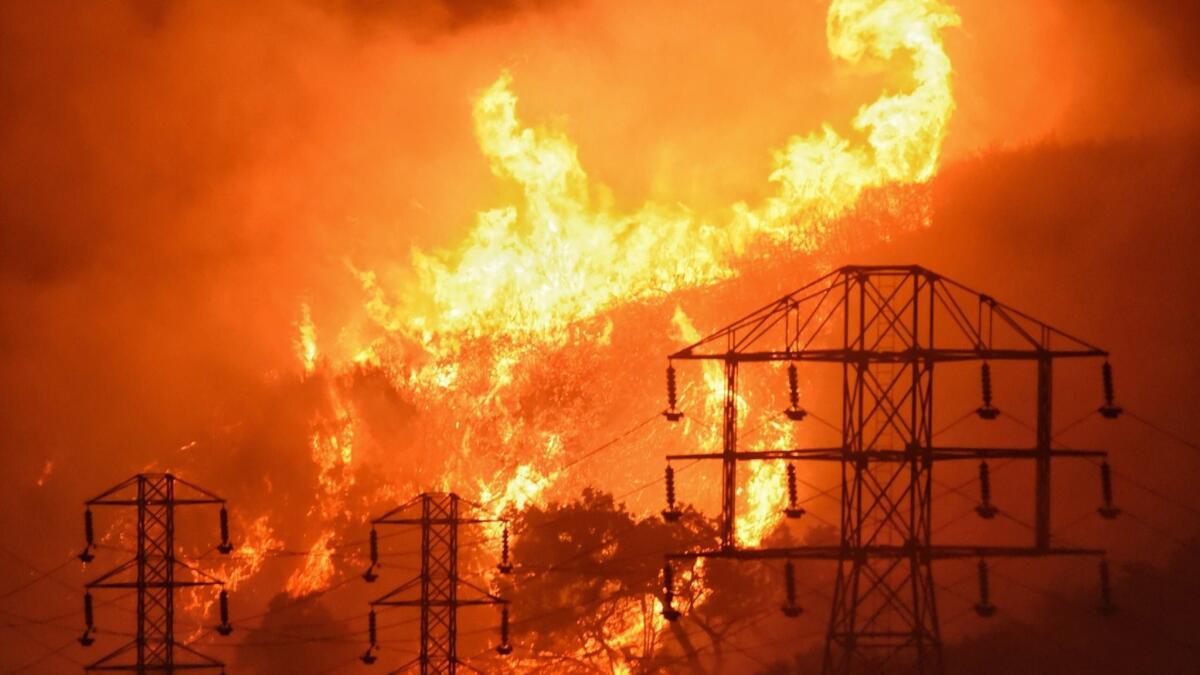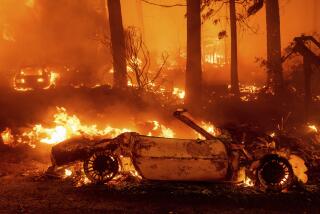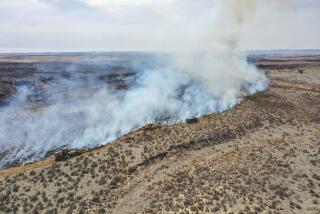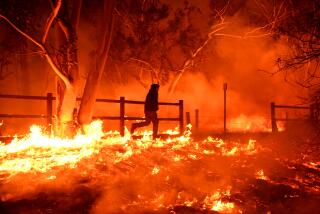Southern California Edison power lines sparked deadly Thomas fire, investigators find

Investigators have determined that Southern California Edison power lines ignited the 2017 Thomas fire, a massive blaze in Ventura and Santa Barbara counties that killed two people and later gave rise to a massive mudflow that resulted in at least 21 deaths.
Following a 15-month probe by Ventura County Fire Department investigators, along with teams from Cal Fire and the U.S. Forest Service, officials found the fire was started by two power lines that slapped together during high winds on the evening of Dec. 4, 2017.
“A high wind event caused the power lines to come into contact with each other, creating an electrical arc,” the Ventura County Fire Department said in a press statement Wednesday. “The electrical arc deposited hot, burning or molten material onto the ground, in a receptive fuel bed, causing the fire. The common term for this situation is called ‘line slap,’ and the power line in question is owned by Southern California Edison.”
In October, the utility said its electrical equipment likely sparked at least one starting point in the massive fire, which burned 281,893 acres. The loss of vegetation in that area ultimately resulted in the collapse of hillsides north of Montecito during heavy rains on Jan. 9, 2018.
In a statement released late Wednesday afternoon, Southern California Edison said it questioned the investigation report, and said the “final resolution as to cause or responsibility” would have to be determined in court. Among other issues, SCE said investigators failed to preserve certain critical evidence — such as video surveillance footage — and suggested investigators failed to consider evidence that would limit their responsibility for the blaze.
The investigators’ finding would appear to put the utility on the hook for not only more than $1.3 billion in insurance claims filed by Thomas fire victims, but also for the $400 million in claims filed after the Montecito slides. Investigators have also forwarded their findings to the state attorney general’s office and said they believed the utility could face charges of involuntary manslaughter, unlawfully causing a fire causing great bodily injury and negligently maintaining their equipment. Such a finding could lead to steep fines and affect the company’s ability to win contracts, experts say.
Attorney Joseph Liebman, who represents more than 500 plaintiffs suing the utility for its role in the Thomas fire and Montecito mudslide, said Wednesday’s findings confirm what he and his clients already knew about the utility’s role in disasters.
“As far as Edison is concerned, it’s game over as far as liability in the case,” Liebman said. “It’s not sufficient for the public utilities to complain about drought-changed conditions and/or climate change and do nothing. The reality is, if you’re going to be a responsible citizen and utility you have to take into account the times may be different and respond accordingly. That means upgrading your infrastructure and if you pass along the costs to the customers, so be it.”
Although Southern California Edison had acknowledged its equipment likely started a fire off Koenigstein Road in Santa Paula, its own investigators concluded that the company was probably not responsible for a second, larger blaze that began in Anlauf Canyon earlier in the evening. The utility said it provided evidence to that effect to investigators, but there was no mention of that evidence in Wednesday’s report.
“SCE has evidence that the ignition at Anlauf Canyon started at least 12 minutes prior to any issue involving SCE’s system,” the company said. “SCE believes the Anlauf Canyon ignition may have been independently responsible for a significant portion of the Thomas Fire damages. SCE also is not aware of any basis for criminal liability.”
In the report released Wednesday, investigators said the Thomas fire first began as two separate fires that joined together and burned for 40 days. They determined the utility was responsible for both ignitions.
“We understand the ramifications around releasing information and making statements in this official report. … It was very thorough,” said Ventura County Fire Capt. Stan Ziegler. He said he was not aware of the evidence Edison said it had in its possession to dispute the findings.
Southern California Edison officials have said they will work with insurance companies to handle the thousands of claims that have accumulated since the Thomas fire and mudflow. The company is protected from going bankrupt over the disasters, thanks to a law signed during the summer that passes excess liability costs on to utility customers.
California’s largest utilities have fallen under increasing criticism over their role in a series of major wildfires.
Last month, Pacific Gas and Electric said its equipment would probably be found responsible for igniting the deadly Camp fire in Butte County on Nov. 8, 2018. PG&E equipment was also responsible for many of the wine country fires in 2017. The company has declared bankruptcy to help shield itself from a mountain of financial liability.
In 2007, San Diego Gas and Electric equipment caused the Witch fire that burned hundreds of homes and led to some 2,000 lawsuits. The company has spent hundreds of millions of dollars shoring up its grid to prevent a repeat of that disaster.
Despite its own recent efforts to protect its power grid, Edison was recently accused of being responsible for November’s Woolsey fire that ripped through Malibu. The investigation into the cause of that fire remains ongoing.
For breaking California news, follow @JosephSerna on Twitter.
More to Read
Start your day right
Sign up for Essential California for news, features and recommendations from the L.A. Times and beyond in your inbox six days a week.
You may occasionally receive promotional content from the Los Angeles Times.







